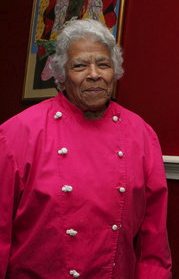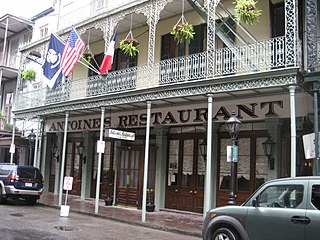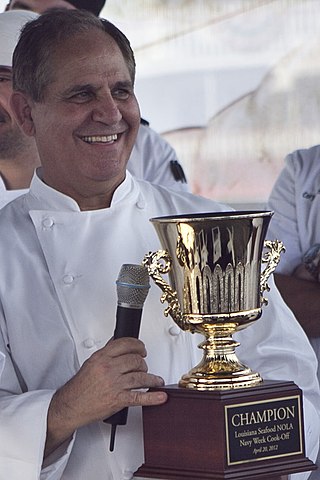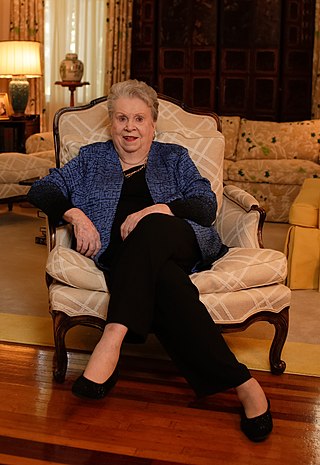
Nellie Murray (c. 1835-1918) was a caterer specializing in Creole cuisine who was born in a family held as slaves in New Orleans and became internationally recognized after her appearance cooking at the 1893 Chicago World Fair.

Nellie Murray (c. 1835-1918) was a caterer specializing in Creole cuisine who was born in a family held as slaves in New Orleans and became internationally recognized after her appearance cooking at the 1893 Chicago World Fair.
Murray was born in about 1835 to parents held as slaves by Paul Octave Hébert, who would later be governor of Louisiana. [1] [2] Her mother and grandmother were both cooks living on Hébert's Bayou Goula plantation, and Murray learned to cook from them. [1] [3]
After Reconstruction Murray created a catering business serving the elite of New Orleans. [1]
Murray gained celebrity status after she served as Chef de Cuisine at the Louisiana Mansion Club at the 1893 Chicago World Fair. [3] [4] The Times-Democrat, referring to her appearance there, called her "the celebrated cook". [5] According to historian Zella Palmer of Dillard University, as a result of her work at the fair, Murray "became an instant celebrity and society ladies in Chicago, New York, Paris and New Orleans booked her months in advance." [3]
The Daily Picayune in 1894 wrote, "Do you know Nellie Murray? To admit that you do not is confession that you are not a member of the New Orleans Four Hundred." [1] The paper called her the "Queen of New Orleans Creole Cuisine". [3] She made a world tour in the late 19th century. [1]
According to Palmer, by the time of her death Murray had "gained legendary status worldwide". [1] [3] [4] Palmer called Murray "the most famed caterer of elite New Orleans society". [3]
Murray spoke out against the New Orleans laws segregating street cars. [1]
The 1890 census lists Murray as living on Polymnia Street. [1] She lived for varying lengths of time in Berlin, Bucharest, Paris, Rome, and Vienna. [1]
Murray had children. [2] She died in 1918 at the age of 82. [2]

Cajun cuisine is a subset of Louisiana cooking developed by the Cajuns, itself a Louisianan development incorporating elements of Native American, West African, French, and Spanish cuisine.

Louisiana Creole cuisine is a style of cooking originating in Louisiana, United States, which blends West African, French, Spanish, and Native American influences, as well as influences from the general cuisine of the Southern United States.

Gumbo is a stew that is popular among the U.S. Gulf Coast community with the New Orleans stew variation the most popular and is the official state cuisine of the U.S. state of Louisiana. Gumbo consists primarily of a strongly flavored stock, meat or shellfish, a thickener, and the Creole "holy trinity": celery, bell peppers, and onions. Gumbo is often categorized by the type of thickener used, whether okra or filé powder.

Jambalaya is a savory rice dish that developed in the U.S. state of Louisiana fusing together African, Spanish, and French influences, consisting mainly of meat or seafood, and vegetables mixed with rice and spices. West Africans and Spanish people each had versions of jambalaya in their respective countries. Historian Ibraham Seck states Senegalese people were making jambalaya. The French introduced tomato to West Africans and they incorporated the crop into their one-pot rice dishes that created jambalaya and enhanced jollof rice. Spanish people made paella which is also a one-pot rice dish cooked with meats and vegetables. These styles of cuisines blended in Louisiana and resulted in cultural and regional variations of the dish.

Paul Prudhomme, also known as Gene Autry Prudhomme, was an American celebrity chef whose specialties were Creole and Cajun cuisines, which he was also credited with popularizing. He was the chef proprietor of K-Paul's Louisiana Kitchen in New Orleans, and had formerly owned and run several other restaurants. He developed several culinary products, including hot sauce and seasoning mixes, and wrote 11 cookbooks.

Red beans and rice is an emblematic dish of Louisiana Creole cuisine traditionally made on Mondays with small red beans, vegetables, spices, and pork bones as left over from Sunday dinner, cooked together slowly in a pot and served over rice. Meats such as ham, sausage, and tasso ham are also frequently used in the dish. The dish is customary – ham was traditionally a Sunday meal and Monday was washday. A pot of beans could sit on the stove and simmer while the women were busy scrubbing clothes. The dish is now fairly common throughout the Southeast. Similar dishes are common in Latin American cuisine, including moros y cristianos, gallo pinto and feijoada.

Dirty rice is a traditional Louisiana Creole dish made from white rice which gets a "dirty" color from being cooked with small pieces of pork, beef or chicken, green bell pepper, celery, and onion, and spiced with cayenne and black pepper. Parsley and chopped green onions are common garnishes. Dirty rice is most common in the Creole regions of southern Louisiana; however, it can also be found in other areas of the American South and referenced as "chicken and rice," "Cajun rice," or "rice dressing".

Leyah (Leah) Chase was an American chef based in New Orleans, Louisiana. An author and television personality, she was known as the Queen of Creole Cuisine, advocating both African-American art and Creole cooking. Her restaurant, Dooky Chase, was known as a gathering place during the 1960s among many who participated in the Civil Rights Movement, and was known as a gallery due to its extensive African-American art collection. In 2018 it was named one of the 40 most important restaurants of the past 40 years by Food & Wine.

Antoine's is a Louisiana Creole cuisine restaurant located at 713 rue St. Louis in the French Quarter of New Orleans, Louisiana. It is one of the oldest family-run restaurants in the United States, having been established in 1840 by Antoine Alciatore. A New Orleans institution, it is notable for being the birthplace of several famous dishes, such as Oysters Rockefeller, pompano en papillote, Eggs Sardou and Pigeonneaux Paradis. Antoine's Cookbook, compiled by Roy F. Guste features hundreds of recipes from the Antoine's tradition. It is also known for its VIP patrons including several U.S. presidents and Pope John Paul II.

Louisiana Creoles are a Louisiana French ethnic group descended from the inhabitants of colonial Louisiana before it became a part of the United States during the period of both French and Spanish rule. They share cultural ties such as the traditional use of the French, Spanish, and Creole languages and predominant practice of Catholicism.
Oysters en brochette is a classic dish in New Orleans Creole cuisine. Raw oysters are skewered, alternating with pieces of partially cooked bacon. The entire dish is then broiled or breaded then either deep fried or sautéed. The traditional presentation is on triangles of toast with the skewer removed and dusted with salt and pepper or topped with either Maitre d'Hotel butter or a Meunière sauce. When prepared well, the dish should have a crispy exterior and a soft savory center with a textural contrast between the bacon and the oyster. It was usually offered on restaurant menus as an appetizer; but was also a popular lunch entrée.

John David Folse is an American chef, restaurant owner, and television host. A lifelong resident of Louisiana, he is seen as a leading authority on Cajun and Creole cuisine and culture.

John Besh is an American chef, TV personality, philanthropist, restaurateur and author. He is known for his sexual assault scandal in addition to efforts in preserving the culinary heritage of New Orleans cuisine.

Ella Brennan was an American restaurateur and part of a family of restaurateurs specializing in haute Louisiana Creole cuisine in New Orleans, Louisiana.

The cuisine of New Orleans encompasses common dishes and foods in New Orleans, Louisiana. It is perhaps the most distinctively recognized regional cuisine in the United States. Some of the dishes originated in New Orleans, while others are common and popular in the city and surrounding areas, such as the Mississippi River Delta and southern Louisiana. The cuisine of New Orleans is heavily influenced by Creole cuisine, Cajun cuisine, and soul food. Later on, due to immigration, Italian cuisine and Sicilian cuisine also has some influence on the cuisine of New Orleans. Seafood also plays a prominent part in the cuisine. Dishes invented in New Orleans include po' boy and muffuletta sandwiches, oysters Rockefeller and oysters Bienville, pompano en papillote, and bananas Foster, among others.

Lena Richard was a chef, cookbook author, restaurateur, frozen food entrepreneur, and television host from New Orleans, Louisiana. In 1949, Richard became the first Black woman to host her own television cooking show. Her show aired from October 1949 - November 1950 on local television station WDSU.
Upperline Restaurant, or simply Upperline, was a fine dining restaurant in New Orleans, Louisiana, United States. Opened in 1983 by restaurateur JoAnn Clevenger, the restaurant was housed in a yellow townhouse located at 1413 Upperline Street in Uptown New Orleans near the St. Charles Streetcar Line. The restaurant focused on and was celebrated for mixing Cajun, Louisiana Creole, and Southern cuisine. Though Clevenger was not a chef, she developed Upperline's signature dish of fried green tomatoes with shrimp rémoulade, and inspired many other menu items. Upperline temporarily closed in March 2020 as a result of the COVID-19 pandemic. In November 2021, Clevenger announced the restaurant would not be reopening and that she and her family planned to sell the building and possibly the business.

Picayune's Creole Cookbook was a cookbook first published in 1900 by the Picayune newspaper in New Orleans. The book contains recipes contributed by white women who had collected them from Black cooks who had created or learned the recipes while enslaved. Recipes represented were developed from the late 18th through the early 20th centuries.

New Orleans hot sausage is a type of sausage used in the cuisine of New Orleans and its surrounding parishes. It’s also used at a lesser extent in the Acadiana region. It’s also known by its French name chaurice.